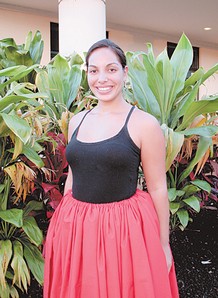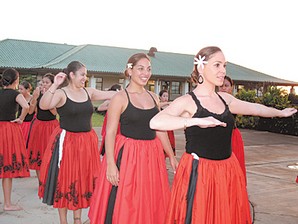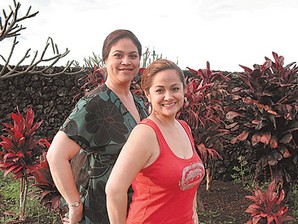The sun was just starting to think about setting. A big, Upcountry Maui "where-the-heck-did-THAT-come-from" rain had saturated the lawns of the sprawling Kamehameha Schools campus, making them downright squishy. So the young women of Halau Na Lei Kaumaka O Uka were out on the concrete circle where the middle school walkways converge, taking themselves through their paces. Their kumu (teachers) were a way off, busy being interviewed.
"They know what they need to do," said kumu hula Napua Greig.
"They know the choreography, now it's just fine-tuning," said Kahulu Maluo-Huber. (They are sisters, who often finish each other's sentences.)
These students had better know the steps and gestures. On the late afternoon of March 17, they were 16 days away from taking the stage for their fifth consecutive appearance at the Merrie Monarch Festival hula competition.
"We started with 14 girls, then 16, then 18. This year we had 42 girls ready to go," Greig said.
Thirty of these will dance on that celebrated stage at the Edith Kanaka'ole Stadium in Hilo.
The dancers were on a plane to Hilo March 20 for two full-day rehearsals on the stadium stage, flew back to Maui on March 21 to perform at Celebration of the Arts in Kapalua, then headed to Hilo for the hula festival, which starts tonight with the Miss Aloha Hula competition. And that's in addition to school, jobs, family responsibilities, all that.
doing it all
Their kumu set the example for being able to do it all — very well — and maintaining a seamless balance between tradition and contemporary life. Preserving ancient chants, observing dietary kapu ... iPhones close at hand.
Maluo-Huber is a mother of a teenage son and works full time at the Maui Arts & Cultural Center. Greig has two young daughters, teaches Hawaiian chant and dance part time at Kamehameha Middle School and is a recording artist — her first CD, "Pihana," has consistently been on the Borders Maui Top Five list since its release last November.
Both of them "do it all" with the help of their family, including their mother Hulu Lindsey, herself a beloved Maui entertainer.
One might wonder why, with such full plates, they add the colossal responsibility of the Merrie Monarch hula competition to the mix. "We go because it's important for us to let people know that hula continues to thrive. Hula is very much alive on Maui," said Maluo-Huber.
"To have dancers excel and not go," added Greig, "it's like going to basketball practice day after day after day ... and never playing a game."
And there's always the love for Maui. "We like to think and hope that we represent Maui's kuleana. It's not just us. We believe the community wants something to be proud of," Greig said. (This year, there are two other Maui halau performing at Merrie Monarch, a rare convergence from the Neighbor Islands.)
And what does it take for 30 members of a halau — plus kumu, plus parents, plus musicians and their instruments, plus implements, plus costumes, plus flowers and foliage for adornments, plus, plus, plus — to get to Merrie Monarch? (Besides practice, practice, practice, of course.) "MONEY. A LOT of money," Maluo-Huber said. They have one major fundraiser each year.
Following tradition
Then there's that touchy subject: the "C" word. Competition. Halau Na Lei Kaumaka O Uka competes, and its kumu make no excuses. "You know, I hear from other kumu, 'Oh, we're traditional. We don't compete,' " said Greig. "We can be part of our tradition and compete. Our tradition is one of competition."
It becomes obvious that this is a serious subject for Greig. "Competition brings out a level of skill in these dancers that is a source of great pride for their families. It also challenges us as kumu. Otherwise, we would all become stagnant. Competition forces us to research, to look, to choreograph from one program to the next. There are many great halau here. Some choose not to compete and that's fine. We choose to compete and we consider ourselves traditional."
She continued, "Our biggest strength is what we have in each other — girls and women knowing that our culture and cultural practices have a place in everyday life."
Maluo-Huber expanded on this theme. "Our students show a willingness to become cultural practitioners. This is not just hula class, it's halau lifestyle." Competition, according to the kumu, is a byproduct.
"Every year we learn. We realize what didn't work, we learn a little bit more about organization, we learn what our weaknesses are," said Greig.
"We order lei earlier," said Maluo-Huber, the halau's flower whiz. "Everybody around us learns, too: 'Next year we're going to do this, buy this.' "
As the logistics become second nature, the kumu and the dancers can focus wholly on hula. "Because everyone helps, it's different now. We've got the logistics down to a science — there's an ironing schedule, a coffee schedule, it's so awesome!" said Napua, who has gone from working herself up into a tizzy into relishing the halau's accomplishments.
So with the kumus' philosophy of competition clear enough, the question that naturally follows is the importance, or perhaps the unimportance, of winning.
They have attracted attention by moving so quickly up the ladder, something rare in recent years for a halau not from O'ahu or the Big Island.
"It's not about perfect footwork or fancy costumes," said Napua, almost wistfully. "It's one night, one dance; it's not the end of life as we know it, we still come back to halau next week, and the world keeps turning. If our own kumu can say they're proud of us, that means much more than winning."
The last word to the dancers from their kumu at their final practice on Maui before they leave for the Merrie Monarch competition in Hilo will be, "Make it good. This is the last time you hula on your own 'aina."
These young women will feel a great responsibility to do their place justice.
Bonnie Friedman is a freelance writer and publicist on Maui.



